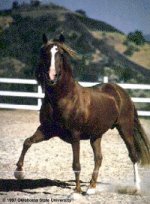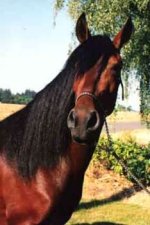♘امیرحسین♞
♘ مدیریت انجمن اسب ایران ♞
Prior to the seventeenth century, most of the world's horses were naturally gaited. Horses that trotted were the exception, and "Boneshakers" as they were called were considered suitable only as pack animals or mounts for servants. Almost all traveling was done on horseback. Since most people knew very little about riding, a smooth riding horse was a necessity. Even Knights - who required trotting horses for battle - often kept a naturally gaited horse which he would ride when traveling, leading his trotting horse behind.
Following the seventeenth century, the uses for trotting horses increased. Networks of roads were built, and people began to travel by horse-drawn vehicles rather than on horseback. Since a horse that trots is more suitable than a gaited horse for pulling a wheeled vehicle, the breeding of trotting horses was increased at the expense of gaited horses. At about the same time, great expanses of land were devoted for the first time to cattle raising, and the horse took on importance as a tool for working the cattle. Here again the trotting horse has a greater advantage over the gaited horse, and even more emphasis was put on the breeding of horses that trotted. Almost simultaneously, worldwide popularity was bestowed upon horse racing, yet another activity where gaited horses do not excel.
As the seventeenth century opened, it was unusual to see a horse that trotted. At the close of the same century, it was unusual to see a horse that did not trot. It was one of the most unusual transformation that horse breeding has ever seen.
As the world's horsemen moved from naturally gaited horses to trotting horses, the Peruvians continued to esteem and breed their naturally gaited "Caballo Peruano de Paso". The Peruvian Paso horse descended from the bloodstock which was introduced to Peru from the Spanish, who at the time were the foremost horse breeders in the world. The Spanish horses brought to Peru blended the Barb, the Friesian, the Spanish Jennet, and the Andalusian. In Peru these Spanish horses were bred to produce the purest link that the modem world has with the once populous gaited horses. For several centuries, no outside blood has been introduced into the Peruvian Paso breed, and it is now the only naturally gaited breed in the world that can guarantee its gait to 100% of its offspring. Every purebred Peruvian horse has the inherited gait, which is the trademark of the Peruvian breed.
In recent years, the world's horsemen have begun to rediscover the pleasures of naturally gaited horses; and horse fanciers from many nations are turning to the Peruvian Paso horse as the ideal mount for the twentieth century horsemen. Thanks to its unique, inbom, four-beat lateral gait, the Peruvian horse is the smoothest riding horses in the world. He is also one of the showiest of all horses because of an inner pride and energy that make him travel with a style and carriage as if always "on parade". The temperament of the Peruvian horse is one of the world's best, thanks to a long standing Peruvian practice of not breeding animals that have an unsuitable disposition. In addition, the Peruvian is the only horse in the world with "termino" , which is a graceful, flowing movement in which the forelegs are rolled towards the outside as the horse strides forward, much like the arm motion of a swimmer. "Termino" is a spectacular and beautiful natural action.
The gait of a Peruvian horse can be as slow as a walk or as fast as an extended trot or slow canter. Both the gait and the flashy leg action are completely natural. They are not induced or aided in any way by artificial training or devices. In fact, both Peru and the United States, Peruvian horses are shown without shoes and with a short, natural hoof.
Peruvian horses come in all basic, solid colors as well as greys and roans. The breed, because of its direct link to the Barb horse, has some striking color tones and shades. The average height of the Peruvian is between 14 and 15 hands, and the weight is commonly between 900 and 1,100 pounds ... about the same as Morgans and Arabians.
Following the seventeenth century, the uses for trotting horses increased. Networks of roads were built, and people began to travel by horse-drawn vehicles rather than on horseback. Since a horse that trots is more suitable than a gaited horse for pulling a wheeled vehicle, the breeding of trotting horses was increased at the expense of gaited horses. At about the same time, great expanses of land were devoted for the first time to cattle raising, and the horse took on importance as a tool for working the cattle. Here again the trotting horse has a greater advantage over the gaited horse, and even more emphasis was put on the breeding of horses that trotted. Almost simultaneously, worldwide popularity was bestowed upon horse racing, yet another activity where gaited horses do not excel.
As the seventeenth century opened, it was unusual to see a horse that trotted. At the close of the same century, it was unusual to see a horse that did not trot. It was one of the most unusual transformation that horse breeding has ever seen.
As the world's horsemen moved from naturally gaited horses to trotting horses, the Peruvians continued to esteem and breed their naturally gaited "Caballo Peruano de Paso". The Peruvian Paso horse descended from the bloodstock which was introduced to Peru from the Spanish, who at the time were the foremost horse breeders in the world. The Spanish horses brought to Peru blended the Barb, the Friesian, the Spanish Jennet, and the Andalusian. In Peru these Spanish horses were bred to produce the purest link that the modem world has with the once populous gaited horses. For several centuries, no outside blood has been introduced into the Peruvian Paso breed, and it is now the only naturally gaited breed in the world that can guarantee its gait to 100% of its offspring. Every purebred Peruvian horse has the inherited gait, which is the trademark of the Peruvian breed.
In recent years, the world's horsemen have begun to rediscover the pleasures of naturally gaited horses; and horse fanciers from many nations are turning to the Peruvian Paso horse as the ideal mount for the twentieth century horsemen. Thanks to its unique, inbom, four-beat lateral gait, the Peruvian horse is the smoothest riding horses in the world. He is also one of the showiest of all horses because of an inner pride and energy that make him travel with a style and carriage as if always "on parade". The temperament of the Peruvian horse is one of the world's best, thanks to a long standing Peruvian practice of not breeding animals that have an unsuitable disposition. In addition, the Peruvian is the only horse in the world with "termino" , which is a graceful, flowing movement in which the forelegs are rolled towards the outside as the horse strides forward, much like the arm motion of a swimmer. "Termino" is a spectacular and beautiful natural action.
The gait of a Peruvian horse can be as slow as a walk or as fast as an extended trot or slow canter. Both the gait and the flashy leg action are completely natural. They are not induced or aided in any way by artificial training or devices. In fact, both Peru and the United States, Peruvian horses are shown without shoes and with a short, natural hoof.
Peruvian horses come in all basic, solid colors as well as greys and roans. The breed, because of its direct link to the Barb horse, has some striking color tones and shades. The average height of the Peruvian is between 14 and 15 hands, and the weight is commonly between 900 and 1,100 pounds ... about the same as Morgans and Arabians.




